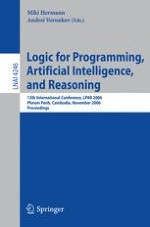2006 | Book
Logic for Programming, Artificial Intelligence, and Reasoning
13th International Conference, LPAR 2006, Phnom Penh, Cambodia, November 13-17, 2006. Proceedings
Editors: Miki Hermann, Andrei Voronkov
Publisher: Springer Berlin Heidelberg
Book Series : Lecture Notes in Computer Science
